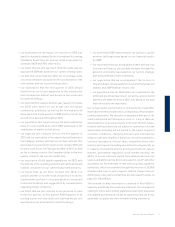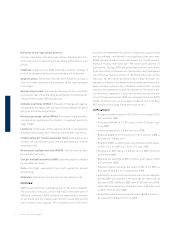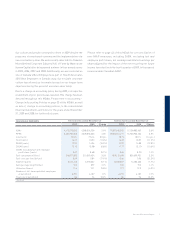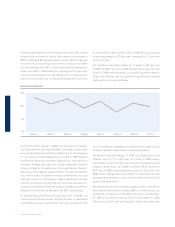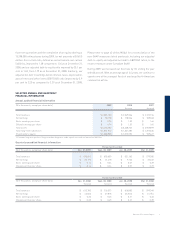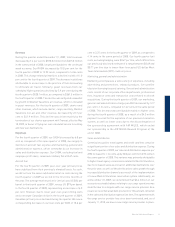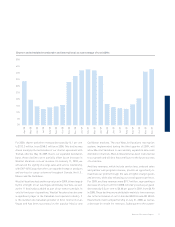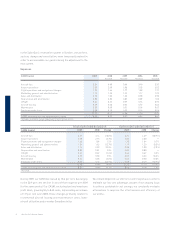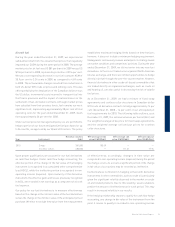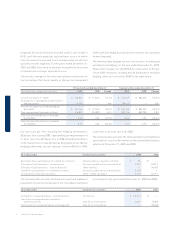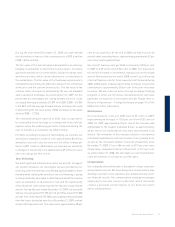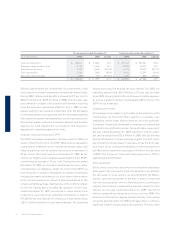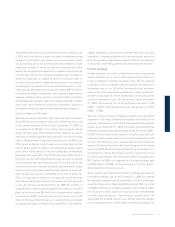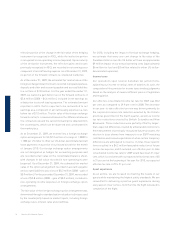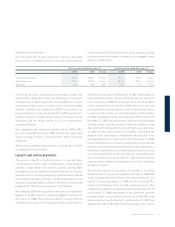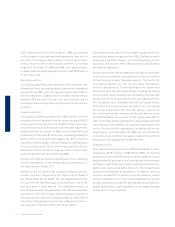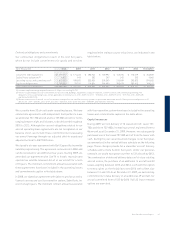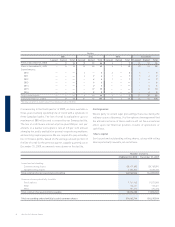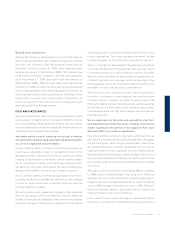Westjet 2009 Annual Report Download - page 45
Download and view the complete annual report
Please find page 45 of the 2009 Westjet annual report below. You can navigate through the pages in the report by either clicking on the pages listed below, or by using the keyword search tool below to find specific information within the annual report.
WestJet 2009 Annual Report 15
establishes maximum hedging limits based on time horizon;
however, it does not include a minimum hedging requirement.
Management continuously reviews and adjusts its strategy based
on market conditions and competitors’ positions. During the year
ended December 31, 2009, we did not enter into any new fuel
derivatives. Jet fuel is not traded on an organized North American
futures exchange, and there are limited opportunities to hedge
directly in jet fuel through the over-the-counter market. However,
fi nancial derivatives in other crude-oil-based commodities that
are traded directly on organized exchanges, such as crude oil
and heating oil, are also useful in decreasing the risk of volatile
fuel prices.
As at December 31, 2009, we had a mixture of fixed swap
agreements and costless collar structures in Canadian-dollar
WTI crude oil derivative contracts to hedge approximately 14 per
cent (December 31, 2008 – 14 per cent) of our anticipated jet
fuel requirements for 2010. The following table outlines, as at
December 31, 2009, the notional volumes per barrel (bbl.) and
the weighted average strike price for fi xed swap agreements,
and the weighted average call and put prices for costless
collar structures.
of effectiveness; accordingly, changes in time value are
recognized in non-operating income (expense) during the period
the change occurs. As a result, a signifi cant portion of the change
in fair value of our options may be recorded as ineffective.
Ineffectiveness is inherent in hedging jet fuel with derivative
instruments in other commodities, such as crude oil, particularly
given the signifi cant volatility observed in the market on crude
oil and related products. Due to this volatility, we are unable to
predict the amount of ineffectiveness for each period. This may
result in increased volatility in our results.
If the hedging relationship ceases to qualify for cash fl ow hedge
accounting, any change in fair value of the instrument from the
point it ceases to qualify is recorded in non-operating income
Aircraft fuel
During the year ended December 31, 2009, we experienced
substantial relief from the elevated fuel prices that negatively
impacted our CASM during the same period in 2008. The average
market price for jet fuel was US $81 per barrel in 2009 versus US
$134 per barrel in 2008, representing a decline of 39.6 per cent.
We saw a corresponding decrease in our fuel costs per ASM of
30.9 per cent to 3.24 cents in 2009, as compared to 4.69 cents
in 2008. These favourable changes resulted from reductions in
both US-dollar WTI crude oil prices and refi ning costs. This was
offset partially by the devaluation of the Canadian dollar versus
the US dollar, incremental costs incurred to transport fuel into
the Prairie provinces and the impact of realized losses on the
settlement of fuel-derivative contracts. Although market prices
have subsided from their previous levels, fuel remains our most
signifi cant cost, representing approximately 28 per cent of total
operating costs for the year ended December 31, 2009, down
from approximately 36 per cent for 2008.
Under our fuel price risk management policy, we are permitted to
hedge a portion of our future anticipated jet fuel purchases for up
to 36 months, as approved by our Board of Directors. The policy
Upon proper qualifi cation, we account for our fuel derivatives
as cash fl ow hedges. Under cash fl ow hedge accounting, the
effective portion of the change in the fair value of the hedging
instrument is recognized in accumulated other comprehensive
loss (AOCL), while the ineffective portion is recognized in non-
operating income (expense). Upon maturity of the derivative
instrument, the effective gains and losses previously recognized
in AOCL are recorded in net earnings as a component of aircraft
fuel expense.
Our policy for our fuel derivatives is to measure effectiveness
based on the change in the intrinsic value of the fuel derivatives
versus the change in the intrinsic value of the anticipated jet fuel
purchase. We elect to exclude time value from the measurement
Year Instrument
Notional volumes
(bbl.)
WTI average strike
price (CAD$/bbl.)
WTI average call
price (CAD$/bbl.)
WTI average put
price (CAD$/bbl.)
2010 Swaps 381,000 103.09 — —
Costless collars 483,000 — 111.21 77.94


